

The nude is classic, timeless, elemental, primal, and universal. Because we are all creatures of our own nakedness, it is the subject of ultimate empathy. And yet in the hands of an artist, that fleeting, imperfect, and fragile package that carries all of our souls gains a noble immortality and perfection that transcends its mere physicality.
In the news:
In April of 2006, Sydney McGee, an elementary art teacher at Wilma Fisher Elementary School (in the Dallas, TX, exurb of Frisco), led fifth graders (11 and 12 years old) through European and contemporary galleries of the Dallas Museum of Art. One of her students saw nude art in the museum, and after the child’s parent complained, Ms McGee was suspended. Although the tour had been approved by the principal, and the 89 students were accompanied by four other teachers, at least twelve parents and a museum docent, Principal Nancy Lawson reprimanded Ms. McGee, saying: “During a study trip that you planned for fifth graders, students were exposed to nude statues and other nude art representations.” Although school representatives have said that other concerns prompted Ms McGee's dismissal, the evidence betrays this school community's gymnophobia. See a NY Times article about this story.
An important goal of education (as it is of art) is to challenge students to consider more advanced ideas. In doing so, viewers must see images that some might consider problematic. Approaching the examination of disturbing subjects, educators are wise to gauge community concerns, and to accomodate them in some ways. Nevertheless, it is generally appropriate to expect that maturing students can and should view many challenging works in a scholarly manner, and that their scholarly pursuits are not be impeded by gymnophobia.
"Nude" is also a name for a color representative of caucasion skin color (sometimes called flesh or peach). See ethnocentrism.
Examples of nudes in the first sense:
Greece, c. 575-570 BCE, Kouros, bronze, height 17 cm, Louvre. See Greek art and kouros.
Apollo Sauroctone (lizard killer), Roman copy of an original attributed to Praxiteles, c. 350 BCE, marble, 58 1/2 inches high (149 cm), Louvre.
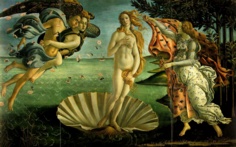
Sandro Botticelli (Italian, 1444-1510), Birth
of Venus, c. 1485, tempera
on canvas, (172.5 x 278.5
cm), Uffizzi Gallery, Florence. See Renaissance.

Albrecht Dürer (German, 1471-1528),
Adam and Eve, 1504, engraving, 9 7/8 x 7 7/8 inches (25.1
x 20.0 cm), Metropolitan Museum of Art, NY. See Northern Renaissance.

Lucas Cranach the Elder (German, 1472-1553),
Venus and Cupid, c. 1525-27, oil
on wood panel,
diameter 4 3/4 inches
(12.1 cm), Metropolitan Museum of Art, NY. See Northern Renaissance.

Michelangelo Buonarroti (Italian, 1475-1564),
Crouching Boy, c.1530-1534, marble,
height 54 cm, Hermitage
Museum, St. Petersburg, Russia. See Renaissance.

Joachim Wtewael (Dutch, 1566-1638), The Golden Age, oil
on copper, 8 7/8 x 12 inches (22.5
x 30.5 cm), Metropolitan Museum of Art, NY.

Peter Paul Rubens (Flemish, 1577-1640), Bacchus, 1638/40, oil
on canvas (transferred
from panel), 75 x 63 1/2 inches (191 x 161.3 cm), Hermitage Museum,
St. Petersburg, Russia. See Baroque
and mythology.

Rembrandt Harmensz. van Rijn (Dutch, 1606-1669),
"Negress" Lying Down, 1658,
etching,
drypoint, and
engraving,
3 3/16 x 6 1/4 inches (8.1 x 15.8 cm), Metropolitan Museum of
Art, NY. See Baroque.

Charles Joseph Natoire (French, 1700-1777),
The Expulsion from Paradise, 1740, oil on copper,
26 3/4 x 19 3/4 inches (67.9 x 50.2 cm), Metropolitan Museum
of Art, NY. See Rococo.

Jean-Auguste-Dominique Ingres and Workshop
(French, 1780-1867), Odalisque in Grisaille, 1824-34, oil on canvas,
32 3/4 x 43 inches (83.2 x 109.2 cm), Metropolitan Museum of
Art, NY. Ingres produced this picture several years after painting
the original color version, The Grand Odalisque, now in
the Louvre. See grisaille,
Neoclassicism,
and odalisque.
Jean-Auguste-Dominique Ingres, The Turkish Bath, 1862, oil on canvas on panel, 1.10 x 1.10 m, Louvre.
Jean-Auguste-Dominique Ingres (French, 1780-1867), Studies of Female Nudes, charcoal and black crayon, 0.620 x 0.450 m, Louvre. See drawing and study.

French Painter, about 1816, Study of a Nude Man, oil
on canvas, 31 3/4 x 25
1/4 inches (80.6 x 64.1 cm), Metropolitan Museum of Art, NY.
This type of study is
known as an academy figure.

Jean-Baptiste-Camille Corot (French, 1796-1875),
Bacchante by the Sea, 1865, oil
on wood panel,
15 1/4 x 23 3/8 inches (38.7 x 59.4 cm), Metropolitan Museum
of Art, NY. See Realism.

Felix Jacques Antoine Moulin (French, 1800-1868),
Two Nudes Standing, c. 1850, daguerreotype, visible: 14.5 x 11.1 cm (5
11/16 x 4 3/8 inches), Metropolitan Museum of Art, NY. See photography.

Jean-Désiré-Gustave Courbet
(French, 1819-1877), The Source, 1862, oil
on canvas, 47 1/4 x 29
1/4 inches (120 x 74.3 cm), Metropolitan Museum of Art, NY. See
Realism.
Édouard Manet (French, 1832-1883), Olympia, 1863, oil on canvas, 4 feet 3 1/2 inches x 6 feet 2 3/4 inches (130 x 190 cm), Musée d'Orsay, Paris. See odalisque and Realism. Manet's work formed a bridge to Impressionism.
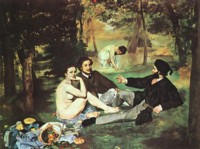
Édouard Manet, Luncheon on the Grass (Le Déjeuner sur
l'herbe), 1863, oil
on canvas, 81 x 101 cm,
Musée d'Orsay.

Sir Lawrence Alma-Tadema (English, 1836-1912),
A Favourite Custom, 1909, oil
on wood, 66.0 x 45.1 cm, Tate
Britain, London.

Paul Cézanne (French, 1839-1906), The Bather, c. 1885, oil on canvas, 50 x 38 1/8 inches (127 x 96.8 cm), Museum of Modern Art, NY. Other Cezanne paintings of bathers. See Post-Impressionism.
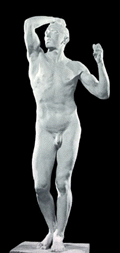
Auguste Rodin (French, 1840-1917), The Age of Bronze, 1877, plaster,
height 173 cm, Hermitage
Museum, St. Petersburg, Russia. See sculpture.

Thomas Eakins (American, 1844-1916), Thomas Eakins and J. Laurie Wallace,
1883, platinum print, 25.5 x 20.4 cm (10 1/16 x 8 1/16 inches),
Metropolitan Museum of Art, NY. See photography.

Childe Hassam (American, 1859-1935), Nude, Appledore, Isle of Shoals, 1913,
oil on canvas,
35 5/8 x 25 1/8 inches, Kemper Museum of Contemporary Art, Kansas
City, MO. Appledore, where Hassam summered for decades, is a
small island in the Atlantic's Isles of Shoals, outside Portsmouth,
New Hampshire. See nude.

Georges Seurat (French 1859-1891), Study for 'Les Poseuses', c. 1887, conté crayon on paper; 11 11/16
x 8 7/8 inches (29.7 x 22.5 cm), Metropolitan Museum of Art,
NY.
Aristide Maillol (French, 1861-1944)
Arthur Bowen Davies (American, 1862-1928), Arethusa, 1901, oil on canvas, 27 1/2 x 22 1/2 inches (69.85 x 57.15 cm), Butler Institute of American Art, Youngstown, OH. See The Eight.

Pierre Bonnard (French, 1867-1947), The Bath, 1925, oil
on canvas, 86.0 x 120.6
cm, Tate Gallery, London. Bonnard painted numerous pictures of
his wife Marthe in the bath. The painter always pictured her
as a young woman even though, at this time, she was in her mid-fifties.
Mm. Bonnard may have spent many hours in the bath because her
doctors advised it as therapy for tuberculosis, or because she
was coping with an obsessive neurosis. See Intimisme.

Henri Matisse (French, 1869-1954), Dance, 1910, oil
on canvas, 102 x 154 inches
(260 x 391 cm), Hermitage Museum, St. Petersburg, Russia. See
circle.
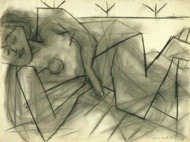
Henri Matisse, Reclining Nude, 1938, charcoal
on paper,
23 5/8 x 31 7/8 inches (60.5 x 81.3 cm), Museum of Modern Art,
NY.

Erich Heckel (German, 1883-1970), Standing Child, 1910, color
woodcut, 14 7/8 x 10 7/8 inches
(37.7 x 27.6 cm), Los Angeles County Museum of Art. See Die Brucke and Expressionism.

Edward Weston (American, 1886-1958), In a Glendale Studio, 1923, platinum
print, Worcester Art Museum, MA. See photography.
Grant Wood (American, 1891-1942), Sultry Night, 1937, lithograph, image 23 x 29.9 cm; sheet 29 x 37.8 cm, Fine Arts Museums of San Francisco, CA. See American Gothic, Art Deco, and American Scene painting.

Bill Brandt (British, born Germany, 1904-1983),
Nude, Campden Hill, London, April 1949,
gelatin silver print, 24.1 x 19.7 cm (9 1/2 x 7 3/4 inches),
Metropolitan Museum of Art, NY. See photography.

Paul Cadmus (1904-1999), Male Nude, c. 1960s, pastel on paper,
14 x 23 3/4 inches, Kemper Museum of Contemporary Art & Design,
Kansas City, MO.

"Balthus" Balthasar Klossowsky
(French, 1908-2001), Figure in Front of a Mantel, 1955, oil on canvas,
75 x 64 1/2 inches (190.5 x 163.9 cm), Metropolitan Museum of
Art, NY.

Philip Pearlstein (American, 1924-), Two Models on a Kilim Rug with Mirror,
1983, oil on canvas,
90 x 72 inches (228.6 x 182.9 cm), Kemper Museum of Contemporary
Art, Kansas City, MO. See gaze,
model, and realism.
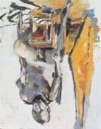
Georg Baselitz (German, 1938-), Male Nude, 1975, oil and charcoal on canvas, 78 3/4 x 63 3/4 inches (200 x 161.9 cm), North Carolina Art Museum, Raleigh. Baselitz paints subjects inverted in order to emphasize his painting's abstract qualities. He has said, "An object painted upside down is suitable for painting because it is unsuitable as an object." See Neo-Expressionism and object.

Robert Mapplethorpe (American, 1946-1989),
Carleton, 1987, gelatin silver print,
edition 1/10, image:
19 1/4 x 19 1/4 inches, paper:
23 5/8 x 19 3/4 inches, Kemper Museum of Contemporary Art, Kansas
City, MO. See photography.
"Beauty is form contemplated without
desire."
Eoin de Leastar
Reference:
Hoepter, L. & Guyas, A. (2008). Removing the Fig Leaf: issues and strategies for handling nudity in the art room. Art Education, vol. 61, #1, p. 39-43.
Also see aidoion, Apollo, censorship, erotica and erotic art, feminism and feminist art, fig leaf, figurative, figure, First Amendment rights, gymnophobia, obscene, odalisque, pornography, voyeurism, and xenophobia.

https://inform.quest/_art